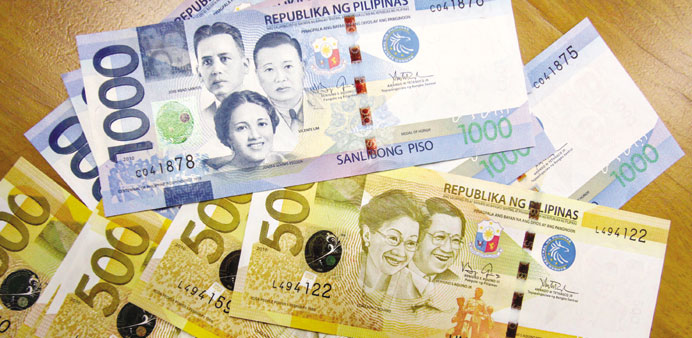Philippines peso bills are seen at the central bank in Manila. The peso weakened the least in the region, falling 0.8%, compared with declines of 6.9% for Indonesia’s rupiah and 7.1% for Malaysia’s ringgit.
Bloomberg/Singapore
Philippine dollar bonds, Southeast Asia’s biggest gainers this year, look set to keep their lead as the peso’s stability shows the economy’s resilience to rising US borrowing costs.
The notes have returned 1.9%, compared with a 1% advance for Indonesian debt and a 1.6% drop in Malaysian securities, according to JPMorgan Chase & Co indexes. The peso weakened the least in the region, falling 0.8%, compared with declines of 6.9% for Indonesia’s rupiah and 7.1% for Malaysia’s ringgit.
While economic growth slowed to a three-year low last quarter as government spending faltered, the Philippines saw its current-account surplus double from a year earlier on strong remittances from Filipinos working overseas and call centre growth. A less-volatile currency decreases the risk of higher foreign-debt servicing costs for the Philippines, which mostly benefits from falling global commodity prices that are harming Malaysia and Indonesia.
“The Philippines has been extremely stable from a macroeconomic perspective,” said Rajeev De Mello, who oversees about $10bn as head of Asian fixed income at Schroder Investment Management Ltd in Singapore. “Malaysia and Indonesia are suffering from the deterioration of their terms of trade,” he said, adding that the Philippines isn’t as sensitive to higher US interest rates.
The peso’s three-month implied volatility is 5.52%, compared with 9.91% for the ringgit and 10.32% for the rupiah. The yield premium investors demand to hold Philippine dollar debt over US Treasuries narrowed 29 basis points this year to 104. The spread for Indonesia fell 13 basis points to 253, while that for Malaysia rose 18 to 189.
Philippine debt is resilient because, credit-wise, the country is on an “improving path” with good tax collection, strong growth and better political governance, said Sergey Dergachev, a senior portfolio manager who helps oversee $13bn of emerging-market debt at Union Investment Privatfonds GmbH in Frankfurt.
“Philippine dollar debt is mostly held by local retail clients and local banks,” he said. “This is a key differentiation with Indonesia where local involvement is relatively thin.”
The current-account surplus in the Philippines was $3.3bn in the first quarter, compared with $1.5bn in the year-earlier period, central bank data show. Central bank Deputy Governor Diwa Guinigundo forecast last month the excess would swell to $14.2bn this year. Remittances rose 5.4% to $7.8bn in the first four months of 2015 from a year earlier. Revenue from business- process outsourcing, which includes call centers, will increase 18% to $21.3bn this year, according to the IT & Business Process Association of the Philippines.
Falling oil prices have benefited the Philippines, a net importer, while weighing on crude exporter Malaysia. Indonesia has been harmed by continued weakness in the prices of commodities like coal, palm oil and tin.
“We selectively like and hold parts of the Philippine sovereign curve,” said Neeraj Seth, the Singapore-based head of Asia credit at BlackRock, which manages $4.77tn globally. The money manager has an “underweight position” in Philippine dollar bonds due to “rich valuations,” he said.
Filipinos will go to the polls in May 2016 to choose a new leader as President Benigno Aquino can’t run for a second six- year term. State spending rose last quarter at about half the pace it did in the previous three months, contributing to GDP growth of 5.2%.
“The recent bottlenecks in spending and election-related noise should limit” the rally in Philippine dollar bonds, said Pedro Florescio, executive vice president and treasurer at BDO Unibank, the nation’s largest lender.
The country’s global debt will be supported by a lack of supply, said Robert Ramos, the Manila-based chief investment officer at Union Bank of the Philippines.
The Bureau of the Treasury is looking at a borrowing mix of 86% local-currency notes in 2016, compared with 84% this year, according to National Treasurer Roberto Tan. The Philippines last tapped the international market in January, when it sold $2bn of 25-year dollar bonds.
“The trend for Philippine dollar bonds’ outperformance over Malaysia and Indonesia will probably continue for a while,” said Takahide Irimura, the Tokyo-based head of emerging-market research at Kokusai Asset Management Co. “The Philippines maintains a solid current-account surplus backed by a stable source of foreign-currency income.”



